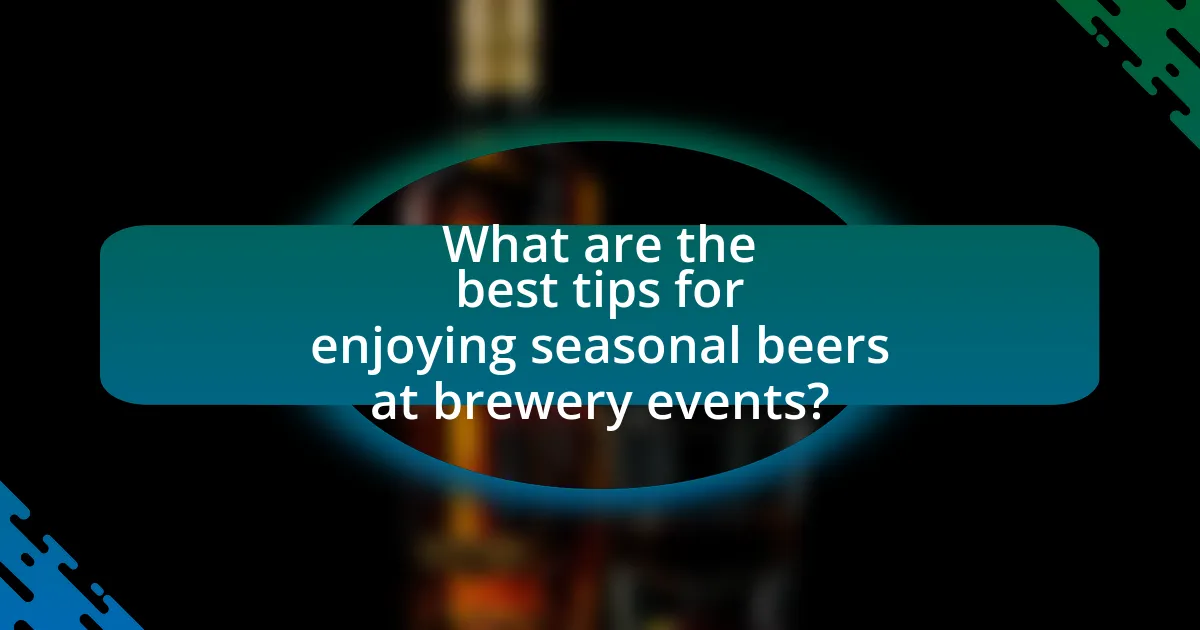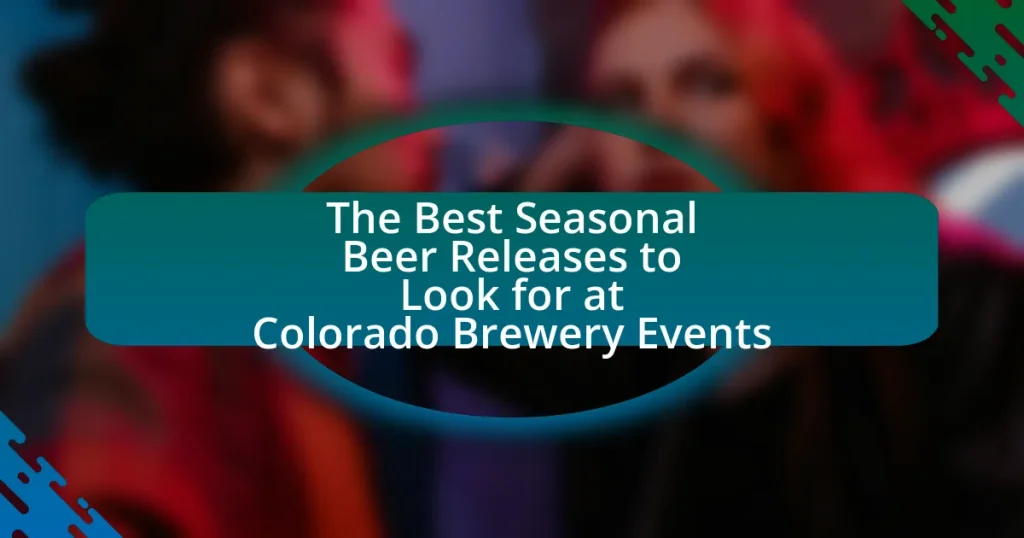The article focuses on the best seasonal beer releases at Colorado brewery events, highlighting notable offerings such as Great Divide Brewing Company’s “Hazy IPA” and Odell Brewing Company’s “Mountain Standard.” It explains how seasonal beers differ from regular offerings by incorporating specific ingredients and flavors that reflect the time of year, influenced by consumer preferences and local traditions. Additionally, the article discusses the factors that shape seasonal beer production, the significance of local ingredients, and the most anticipated brewery events in Colorado, providing insights into the vibrant craft beer culture of the state.

What are the Best Seasonal Beer Releases at Colorado Brewery Events?
The best seasonal beer releases at Colorado brewery events include the Great Divide Brewing Company’s “Hazy IPA,” which is known for its juicy hop profile and is released in the summer. Additionally, Odell Brewing Company’s “Mountain Standard” is a popular winter release, celebrated for its rich malt character and balanced bitterness. These selections are often highlighted at various brewery events throughout the state, showcasing Colorado’s craft beer innovation and seasonal flavors.
How do seasonal beer releases differ from regular offerings?
Seasonal beer releases differ from regular offerings primarily in their availability and flavor profiles, as they are crafted to reflect specific seasons or holidays. Seasonal beers often incorporate ingredients that are characteristic of the time of year, such as spices in winter ales or fresh fruits in summer brews, which enhances their uniqueness compared to year-round beers that maintain consistent flavors. For example, pumpkin ales are typically released in the fall, utilizing pumpkin and spices, while summer wheat beers may feature citrus or floral notes. This seasonal approach not only caters to consumer preferences during different times of the year but also allows breweries to experiment with new recipes and ingredients, creating a dynamic and varied beer landscape.
What factors influence the creation of seasonal beers?
The creation of seasonal beers is influenced by factors such as seasonal ingredients, cultural traditions, and consumer preferences. Seasonal ingredients, like pumpkin in fall or fresh hops in summer, dictate the flavor profiles and styles of these beers. Cultural traditions, such as Oktoberfest or holiday celebrations, inspire breweries to craft specific styles that resonate with these events. Additionally, consumer preferences shift throughout the year, prompting breweries to innovate and release beers that align with seasonal tastes, such as lighter ales in warmer months and richer stouts in colder months. These factors collectively shape the seasonal beer landscape, ensuring that offerings remain relevant and appealing to consumers.
How do breweries decide on seasonal flavors and styles?
Breweries decide on seasonal flavors and styles based on consumer preferences, seasonal ingredients, and market trends. They analyze sales data and customer feedback to identify popular flavors during specific times of the year, such as pumpkin ales in fall or light lagers in summer. Additionally, breweries often collaborate with local farmers to source seasonal ingredients, ensuring freshness and supporting local agriculture. Market research also plays a crucial role, as breweries monitor industry trends and competitor offerings to innovate and differentiate their seasonal releases. This strategic approach helps breweries create appealing products that resonate with their target audience while maximizing sales opportunities.
Why are Colorado breweries known for their seasonal beer events?
Colorado breweries are known for their seasonal beer events due to the state’s diverse climate and rich brewing culture. The variation in weather allows breweries to create unique seasonal brews that reflect local ingredients and traditions, such as pumpkin ales in the fall and refreshing wheat beers in the summer. Additionally, Colorado’s craft beer scene is vibrant, with over 400 breweries, fostering a competitive environment that encourages innovation and seasonal releases. This commitment to seasonal offerings is further supported by events like the Great American Beer Festival, which showcases these unique brews and attracts beer enthusiasts from across the country.
What unique characteristics define Colorado’s brewing culture?
Colorado’s brewing culture is defined by its emphasis on craft beer, innovation, and a strong community connection. The state is home to over 400 breweries, making it one of the leading craft beer destinations in the United States. This culture is characterized by a diverse range of beer styles, including IPAs, stouts, and sours, often influenced by local ingredients and brewing techniques. Additionally, Colorado breweries frequently engage with their communities through events, collaborations, and sustainability initiatives, fostering a sense of local pride and environmental responsibility. The state’s high altitude and pure water sources also contribute to the unique flavor profiles of its beers, further distinguishing Colorado’s brewing scene.
How do local ingredients impact seasonal beer production?
Local ingredients significantly enhance seasonal beer production by providing unique flavors and characteristics that reflect the region’s terroir. Seasonal beers often utilize ingredients that are at their peak during specific times of the year, such as fresh hops in the fall or fruits in the summer, which can lead to distinctive taste profiles. For example, Colorado breweries frequently incorporate locally sourced ingredients like Colorado-grown barley and hops, which not only support local agriculture but also create a sense of place in the beer. This practice is validated by the growing trend among craft breweries to emphasize local sourcing, as seen in the Colorado Brewers Guild’s initiatives promoting local ingredients, thereby fostering community and sustainability within the brewing industry.
What are the most anticipated seasonal beer events in Colorado?
The most anticipated seasonal beer events in Colorado include the Great American Beer Festival, held annually in Denver, and the Colorado Brewers’ Festival in Fort Collins. The Great American Beer Festival, recognized as one of the largest beer festivals in the country, showcases thousands of beers from hundreds of breweries, attracting beer enthusiasts from across the nation. The Colorado Brewers’ Festival features local breweries and offers tastings, food pairings, and live music, celebrating the state’s vibrant craft beer culture. These events are significant for their scale and the opportunity they provide for breweries to present their seasonal releases, making them key highlights in Colorado’s beer calendar.
Which breweries host the most popular seasonal beer events?
The breweries that host the most popular seasonal beer events in Colorado include New Belgium Brewing, Odell Brewing Company, and Avery Brewing Company. New Belgium Brewing is renowned for its annual “Fat Tire Celebration,” which attracts thousands of attendees each year. Odell Brewing Company hosts the “Odell’s Seasonal Release Party,” showcasing their innovative seasonal brews, while Avery Brewing Company is famous for its “Avery Strong Ale Fest,” featuring a wide range of seasonal and specialty beers. These events consistently draw large crowds and are highly anticipated within the craft beer community, demonstrating their popularity and significance in Colorado’s beer culture.
What types of seasonal beers can attendees expect at these events?
Attendees can expect a variety of seasonal beers at these events, including pumpkin ales, winter warmers, and spring IPAs. Pumpkin ales are typically brewed with spices like cinnamon and nutmeg, reflecting the fall season. Winter warmers are rich, malty beers often featuring flavors like caramel and toffee, designed to provide warmth during colder months. Spring IPAs are characterized by their floral and citrus notes, aligning with the freshness of the season. These seasonal offerings are crafted by local breweries to celebrate the unique flavors associated with each time of year, enhancing the overall experience for attendees.

What should you know before attending a Colorado brewery event?
Before attending a Colorado brewery event, you should know the specific seasonal beer releases that will be available, as these events often showcase limited-time offerings. Colorado breweries frequently highlight unique flavors and styles that reflect local ingredients and brewing traditions, such as pumpkin ales in the fall or refreshing IPAs in the summer. Understanding the event’s schedule and the breweries participating can enhance your experience, as many events feature tastings, food pairings, and opportunities to meet brewers. Additionally, checking for any entry fees, age restrictions, and whether tickets are required can help you prepare adequately for the event.
How can you prepare for a seasonal beer event?
To prepare for a seasonal beer event, attendees should research the breweries participating and their featured seasonal releases. This preparation allows individuals to identify specific beers they want to try, enhancing their overall experience. Additionally, checking the event schedule for tastings, food pairings, and special activities can help attendees plan their visit effectively. Engaging with brewery social media pages or websites can provide insights into exclusive releases and event details, ensuring a well-informed attendance.
What are the best practices for tasting seasonal beers?
The best practices for tasting seasonal beers include evaluating appearance, aroma, flavor, mouthfeel, and finish. First, observe the beer’s color and clarity, which can indicate its style and ingredients. Next, swirl the beer gently in the glass to release its aromas, then take a moment to inhale deeply, identifying various scents such as hops, malt, or seasonal spices.
When tasting, take a small sip and let the beer coat your palate, noting the balance of sweetness, bitterness, and any unique seasonal flavors. Pay attention to the mouthfeel, which can range from light and crisp to rich and creamy, and finally, consider the finish, assessing how long the flavors linger after swallowing.
These practices enhance the tasting experience and allow for a deeper appreciation of the seasonal variations in flavor and style, which are often influenced by the ingredients available during specific times of the year.
How can you maximize your experience at brewery events?
To maximize your experience at brewery events, plan ahead by researching the breweries participating and their seasonal beer releases. Engaging with the breweries’ social media or websites can provide insights into special offerings and events, such as tastings or food pairings. Additionally, arriving early allows you to avoid crowds and secure a spot for popular tastings. According to a survey by the Brewers Association, attendees who plan their visits tend to sample a wider variety of beers and have a more enjoyable experience.
What are the common themes in seasonal beer releases?
Common themes in seasonal beer releases include the use of seasonal ingredients, flavor profiles that reflect the time of year, and traditional brewing styles associated with specific seasons. For instance, winter releases often feature spices like cinnamon and nutmeg, while summer beers may incorporate fruits such as citrus or berries. Additionally, many breweries create limited-edition brews that celebrate local harvests or cultural events, enhancing community engagement. This trend is supported by the craft beer industry’s focus on innovation and seasonal marketing strategies, which aim to attract consumers looking for unique and timely offerings.
How do breweries incorporate local traditions into their seasonal beers?
Breweries incorporate local traditions into their seasonal beers by utilizing regional ingredients, brewing techniques, and cultural themes that reflect the community’s heritage. For example, many Colorado breweries use locally sourced grains, hops, and fruits to create unique flavors that resonate with the area’s agricultural practices. Additionally, seasonal beers often celebrate local festivals or historical events, such as Oktoberfest-inspired brews that pay homage to German heritage, which is significant in Colorado’s brewing culture. This approach not only enhances the authenticity of the beer but also fosters a connection between the brewery and the local community, as seen in events like the Great American Beer Festival, where many breweries showcase their seasonal offerings that highlight these traditions.
What seasonal beer styles are trending in Colorado?
The seasonal beer styles trending in Colorado include pumpkin ales, winter warmers, and sour ales. Pumpkin ales are popular in the fall, characterized by their spiced flavors and often brewed with real pumpkin. Winter warmers, typically rich and malty, are favored during the colder months for their comforting qualities. Sour ales, which have gained traction in recent years, are enjoyed year-round but see a spike in popularity during the summer months due to their refreshing tartness. These trends reflect the local breweries’ focus on seasonal ingredients and consumer preferences, showcasing Colorado’s diverse craft beer culture.

What are the best tips for enjoying seasonal beers at brewery events?
To enjoy seasonal beers at brewery events, focus on sampling a variety of styles and flavors. This approach allows you to appreciate the unique characteristics of each seasonal release, such as pumpkin ales in fall or refreshing wheat beers in summer. Additionally, engage with brewery staff to gain insights about the brewing process and the ingredients used, enhancing your understanding and enjoyment of the beers. Pairing seasonal beers with complementary food options available at the event can also elevate the tasting experience, as certain flavors can enhance or contrast with the beer’s profile. Lastly, take notes on your favorites to remember which seasonal beers to seek out in the future, as many breweries offer limited releases that may not be available year-round.
How can you effectively pair seasonal beers with food?
To effectively pair seasonal beers with food, consider the flavor profiles of both the beer and the dish. For example, a rich, malty winter ale complements hearty stews, while a crisp, citrusy summer lager pairs well with light salads and seafood. Research indicates that matching the intensity of flavors enhances the dining experience; thus, stronger beers should accompany robust dishes, and lighter beers should be served with milder fare. This approach is supported by the Beer and Food Pairing Guide, which emphasizes balancing flavors to elevate both the beer and the meal.
What food options complement popular seasonal beer styles?
Food options that complement popular seasonal beer styles include grilled meats for summer lagers, hearty stews for winter ales, and spicy dishes for autumn pumpkin beers. Grilled meats, such as burgers and sausages, enhance the crispness of summer lagers, while the rich flavors of winter ales pair well with the depth of hearty stews. Additionally, the sweetness of pumpkin beers is balanced by the heat of spicy dishes, creating a harmonious dining experience. These pairings are supported by culinary traditions that emphasize matching the intensity and flavor profiles of food and beer, ensuring an enjoyable tasting experience.
How does food pairing enhance the tasting experience?
Food pairing enhances the tasting experience by creating complementary flavors that elevate both the food and the beverage. When specific foods are matched with particular beers, the interaction between the ingredients can amplify taste sensations, making them more enjoyable. For example, a hoppy IPA can balance the richness of a fatty dish, while a fruity wheat beer can enhance the sweetness of a dessert. Studies have shown that pairing food and drink can lead to a more satisfying overall experience, as the right combinations can enhance aromas and flavors, leading to a more complex palate.
What should you consider when selecting seasonal beers to try?
When selecting seasonal beers to try, consider the flavor profile, availability, and local brewery offerings. Flavor profiles often reflect seasonal ingredients, such as pumpkin in fall or citrus in summer, which can enhance the drinking experience. Availability is crucial, as seasonal beers are typically produced in limited quantities, making it important to seek out fresh releases. Additionally, exploring local breweries can provide unique options that highlight regional ingredients and brewing styles, contributing to a more authentic tasting experience.
How can you identify quality seasonal beers at events?
To identify quality seasonal beers at events, focus on breweries with a strong reputation and awards. Established breweries often showcase seasonal beers that have received accolades, indicating quality. Additionally, look for beers that use fresh, local ingredients, as these often enhance flavor and authenticity. For example, seasonal beers that highlight Colorado-grown hops or fruits can provide a unique taste profile that reflects the region. Engaging with knowledgeable staff or brewers at the event can also provide insights into the brewing process and ingredient sourcing, further validating the quality of the seasonal offerings.
What role does personal preference play in beer selection?
Personal preference significantly influences beer selection, as individual tastes dictate the types of flavors, aromas, and styles that consumers enjoy. For instance, some individuals may prefer hoppy IPAs for their bitterness, while others might favor malty stouts for their sweetness. Research indicates that personal preferences are shaped by factors such as past experiences, cultural background, and sensory perceptions, which all contribute to the decision-making process in selecting a beer. This is supported by studies showing that consumers often gravitate towards familiar styles or flavors that align with their previous positive experiences, thereby reinforcing their choices in future selections.


